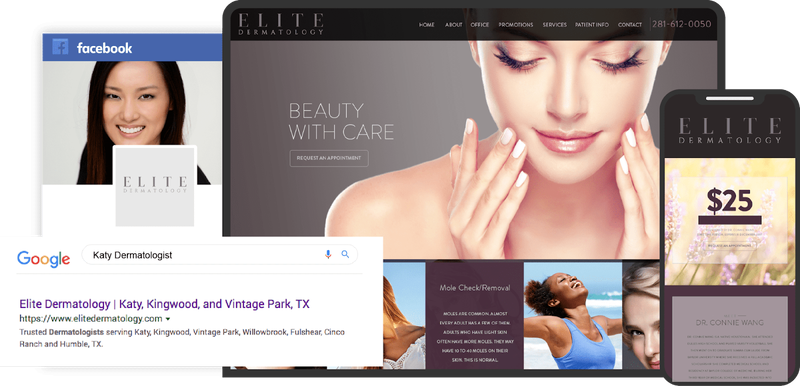How Dermatologists Can Attract Potential Patients with Content Marketing
Before digital communication became commonplace, traditional marketing practices included the production of flyers, brochures, posters and newspaper inserts.
These are all examples of content marketing.
Digital communications adds blog posts, social media messaging, discussion forums and message boards, e-books, e-newsletters, webinars, websites, videos, podcasts and more to that list.
The growing list of content marketing options gives dermatologists more ways to reach existing patients and potential new patients with information, educational material, calls to action and brand maximization.
The 5 basic rules for dermatology content marketing
Identify your patients’ needs and keep your messaging relevant to those needs. Don’t drift off into too much background about your practice; keep it relevant to your patients.
Do stay relatable and conversational and don’t get too technical or boring. Phrase your content in ways that people can relate to easily; use people-oriented narratives, while remaining authoritative and professional. Concentrate more on patient experience than on scientific data.
Take the focus off of self-promotion. Engage with your audience, build relationships and trust, present unbiased information and let your audience decide for themselves to use your practice.
Be patient. Benefits of content marketing likely won’t be immediate. It takes time to grow a loyal following. In the meantime, keep coming up with fresh content.
Go for sustainable marketing efforts. Become a reliable, timely source of information. Update content often. Through consistency, you’ll win more visitors.
Dermatology Marketing: Digital Marketing and Social Media

Use both evergreen content and time-sensitive content for optimized engagement
Evergreen content
What is evergreen content? It simply means ever-relevant content – it doesn’t age, lose value, or become outdated.
The information will continue to be accurate, interesting and valuable to readers over time.
For example, how-to articles that address a concern can contain “evergreen content,” such as the top 5 signs of acne, supported with general tips and advice, case studies and statistics.
Your dermatology website should include some evergreen content so that it will serve as a reliable source of information for your patients. Over the long-term, evergreen content may draw in new patients through backlinks, SEO and lead generation.
What are the benefits of time-sensitive content?
Relevance and engagement are two things that time-sensitive content delivers. Some examples:
- Seasonal—content related to holidays or weather, special occasions such as Mother’s Day, Christmas, Valentine’s Day
- News—New products and treatments, groundbreaking research
- Trending—Celebrity styles, viral videos, other relevant trends
- Frequently changing topics—The latest laser technology, “most popular” lists, reviews of cosmetic products
Below are some reasons time-sensitive content works well:
- Great short-term results. An article or social media post announcing a medical breakthrough would attract high traffic volume for a short time and could go viral.
- Social media maximization. Social media users typically discuss the present and the immediate future. Your time-sensitive content could dominate conversations while a topic is hot.
- Audience loyalty. A regular supply of fresh, trending topics will keep audiences coming back to the website or blog. Be creative, be current, and your audience will grow. Time-sensitive content will help keep your page relevant, especially if it is added consistently.
- Search Engine Optimization. Google has a preference for fresh, original content and websites that are frequently updated. Use time-sensitive content to boost your visibility in searches.
The key is to find the perfect balance

The ideal dermatology content marketing plan has both evergreen and time-sensitive content. The line between both types may blur from time to time, but you can hire us to help you plan your content calendar. Here is a simple example: If you post a blog or an article discussing derma fillers, it is considered evergreen content since it may be relevant for many years. On the other hand, talking about the top 25 celebrities who have used derma fillers is an example of a time-sensitive topic.
Always refresh your content with updates
Consistency is key in content marketing. Post regular updates to your blog and website content to keep articles relevant. When groundbreaking scientific research, product launches, or other events render your content outdated, change it and post something more timely. For blogs and other dated articles, add a note of when it was updated and summarize what changed. Regular updates provide the benefit of increasing the content’s freshness factor, which improves search rankings.
Some time-sensitive content can be made relevant again with a few quick updates. This is especially true of holiday articles and videos. An article on allergens and impurities in cheap Halloween makeup can be just as valuable next October as it was last year. Add a little new information and turn it into a current post, updated for this year.
Re-use highly engaging content
Who says recycling doesn’t apply to content marketing? You can definitely recycle old content without an update. But remember to share links.
For example, you could post new information about this year’s deals on holiday treatment specials while linking to last year’s post about similar deals. A new, current article can include links to old posts that provide background information.
If you want to bring old content back to life, either add updates or share links. Google will see two pages with identical blocks of text and regard them as duplicate content. The older page will drop in search ranking, and the new page will probably never rank well.
In conclusion, to attract patients with content marketing, remember to stay focused on patient needs, use both time-sensitive and evergreen content, be consistent and be patient.
Before digital communication became commonplace, traditional marketing practices included the production of flyers, brochures, posters and newspaper inserts.
These are all examples of content marketing.
Digital communications adds blog posts, social media messaging, discussion forums and message boards, e-books, e-newsletters, webinars, websites, videos, podcasts and more to that list.
The growing list of content marketing options gives dermatologists more ways to reach existing patients and potential new patients with information, educational material, calls to action and brand maximization.
The 5 basic rules for dermatology content marketing
Identify your patients’ needs and keep your messaging relevant to those needs. Don’t drift off into too much background about your practice; keep it relevant to your patients.
Do stay relatable and conversational and don’t get too technical or boring. Phrase your content in ways that people can relate to easily; use people-oriented narratives, while remaining authoritative and professional. Concentrate more on patient experience than on scientific data.
Take the focus off of self-promotion. Engage with your audience, build relationships and trust, present unbiased information and let your audience decide for themselves to use your practice.
Be patient. Benefits of content marketing likely won’t be immediate. It takes time to grow a loyal following. In the meantime, keep coming up with fresh content.
Go for sustainable marketing efforts. Become a reliable, timely source of information. Update content often. Through consistency, you’ll win more visitors.
Dermatology Marketing: Digital Marketing and Social Media
Use both evergreen content and time-sensitive content for optimized engagement
Evergreen content
What is evergreen content? It simply means ever-relevant content – it doesn’t age, lose value, or become outdated.
The information will continue to be accurate, interesting and valuable to readers over time.
For example, how-to articles that address a concern can contain “evergreen content,” such as the top 5 signs of acne, supported with general tips and advice, case studies and statistics.
Your dermatology website should include some evergreen content so that it will serve as a reliable source of information for your patients. Over the long-term, evergreen content may draw in new patients through backlinks, SEO and lead generation.
What are the benefits of time-sensitive content?
Relevance and engagement are two things that time-sensitive content delivers. Some examples:
- Seasonal—content related to holidays or weather, special occasions such as Mother’s Day, Christmas, Valentine’s Day
- News—New products and treatments, groundbreaking research
- Trending—Celebrity styles, viral videos, other relevant trends
- Frequently changing topics—The latest laser technology, “most popular” lists, reviews of cosmetic products
Below are some reasons time-sensitive content works well:
- Great short-term results. An article or social media post announcing a medical breakthrough would attract high traffic volume for a short time and could go viral.
- Social media maximization. Social media users typically discuss the present and the immediate future. Your time-sensitive content could dominate conversations while a topic is hot.
- Audience loyalty. A regular supply of fresh, trending topics will keep audiences coming back to the website or blog. Be creative, be current, and your audience will grow. Time-sensitive content will help keep your page relevant, especially if it is added consistently.
- Search Engine Optimization. Google has a preference for fresh, original content and websites that are frequently updated. Use time-sensitive content to boost your visibility in searches.
The key is to find the perfect balance
The ideal dermatology content marketing plan has both evergreen and time-sensitive content. The line between both types may blur from time to time, but you can hire us to help you plan your content calendar. Here is a simple example: If you post a blog or an article discussing derma fillers, it is considered evergreen content since it may be relevant for many years. On the other hand, talking about the top 25 celebrities who have used derma fillers is an example of a time-sensitive topic.
Always refresh your content with updates
Consistency is key in content marketing. Post regular updates to your blog and website content to keep articles relevant. When groundbreaking scientific research, product launches, or other events render your content outdated, change it and post something more timely. For blogs and other dated articles, add a note of when it was updated and summarize what changed. Regular updates provide the benefit of increasing the content’s freshness factor, which improves search rankings.
Some time-sensitive content can be made relevant again with a few quick updates. This is especially true of holiday articles and videos. An article on allergens and impurities in cheap Halloween makeup can be just as valuable next October as it was last year. Add a little new information and turn it into a current post, updated for this year.
Re-use highly engaging content
Who says recycling doesn’t apply to content marketing? You can definitely recycle old content without an update. But remember to share links.
For example, you could post new information about this year’s deals on holiday treatment specials while linking to last year’s post about similar deals. A new, current article can include links to old posts that provide background information.
If you want to bring old content back to life, either add updates or share links. Google will see two pages with identical blocks of text and regard them as duplicate content. The older page will drop in search ranking, and the new page will probably never rank well.
In conclusion, to attract patients with content marketing, remember to stay focused on patient needs, use both time-sensitive and evergreen content, be consistent and be patient.



